Gomphidius roseus (Fr.) Fr. - Rosy Spike
Phylum: Basidiomycota - Class: Agaricomycetes - Order: Boletales - Family: Gomphidiaceae
Distribution - Taxonomic History - Etymology - Identification - Culinary Notes - Reference Sources
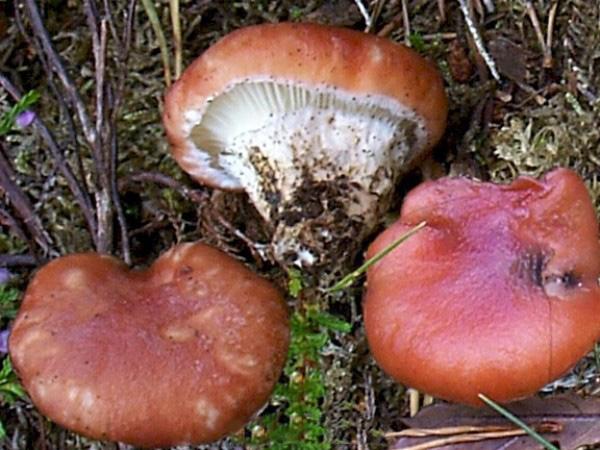
Gomphidius roseus, a gilled fungus of the order Boletales, is quite often found beneath pines, particularly where bilberries grow. These striking red 'spikes' are very easy to spot despite their small size. Not only does the complete fruitbody resemble a nail or at least a blunt spike (the rounded cap being the 'head' attached to a sharply tapering stem - the point of the nail) but occasionally there is also a small central umbo giving the mushroom an appearance of being a two nails sharing a common head'.
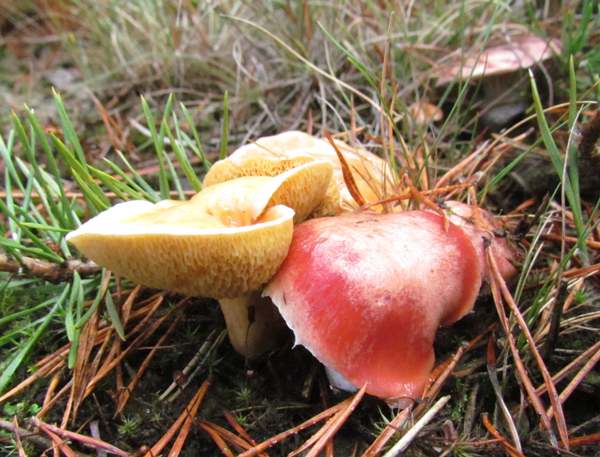
Often when you find this species you will find alongside it Suillus bovinus, the Bovine Bolete (also referred to as the Jersey Cow Bolete), with which it forms a complex three-way mycorrhizal relationship with pine trees - however, the Rosy Spike's involvement is thought to be parasitic. The picture above and below show just how closely linked these fungi can be; below soil level the mycelia of the two species are bonded together.
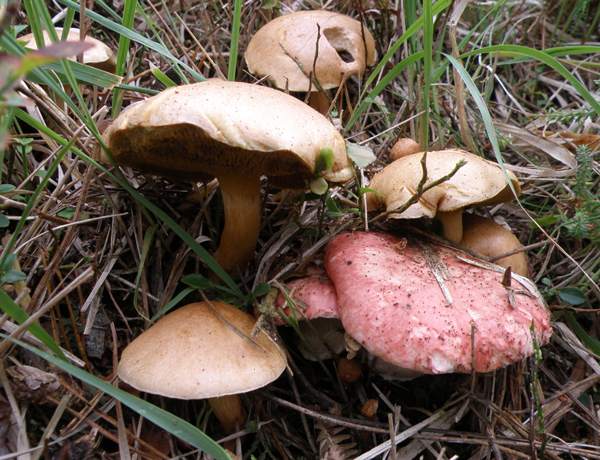
Distribution
Infrequent but found throughout Britain and Ireland; the Rosy Spike is also fairly common in many parts of mainland Europe. Gomphidius roseus is not recorded from America; however, a similar species, Gomphidius subroseus, first described in 1925 by Calvin Henry Kauffman (1869 - 1931), is found in North America. Like its European cousin, this species is often seen alongside a bolete of the Suillus genus, in this case Suillus lakei, commonly known as Matte Jack.
Suillus lakei, also known as Lake's Bolete or the Western Painted Suillus, is not native to Europe but it has been introduced into some European countries along with imported Douglas Firs; however, there is as yet no evidence that Gomphidius subroseus came along with them for the ride!
Taxonomic history
The Rosy Spike was described scientifically in 1838 by the Swedish mycologist Elias Magnus Fries, who gave it the binomial scientific name Gomphidius roseus.
Synonyms of Gomphidius roseus include Agaricus glutinosus ß roseus Fr., and Gomphus glutinosus var. roseus (Fr.) P. Kumm.
Etymology
Gomphidius comes from the Greek 'gomphos', a large conical (wedge-like) nail or bolt with a large head, made of either metal or wood and used mainly in ship-building. The conical shape of the fruitbodies means that they look somewhat like those ancient bolts.
The specific epithet roseus hardly needs explaining, but for completeness it comes from Latin and means rosy (red).
Identification guide
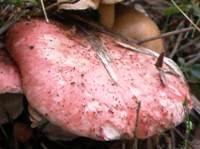 |
CapOften rosy red when young, the caps of Gomphidius roseus turn brick red as they mature. Irregular and occasionally lobed, the caps range from 3 to 5cm across and retain turned-down margins even when fully expanded. In wet weather, the caps are viscid, becoming smooth and shiny when dry. Beneath the cuticle, the flesh is white and firm. |
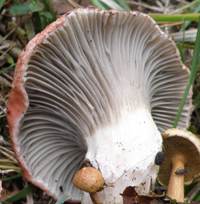 |
GillsAlthough a boletales species, Gomphidius roseus has thick gills rather than pores. Deeply decurrent, the gills are pale grey, eventually turning mouse grey (as seen in the picture on the left) as the fruitbody ages. StemThe dirty-white stem has an often poorly-defined glutinous ring, but the ring zone becomes more obvious when it becomes stained with black spores as the fruitbody ages; the lower part of the stem and is often tinged pink but with a yellowish zone near to the base. 3 to 7cm long and typically 5 to 10mm in diameter, most of the stem is buried in grass or pine needles so that the cap appears to be almost flush with the ground. Usually the stem tapers inwards towards the base. Firm and solid, the stem flesh is white shading to dirty yellow at the base. |
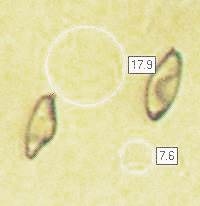 |
SporesSubfusiform, smooth, 16-20 x 5-8μm. Spore printBlack. |
Odour/taste |
Not distinctive. |
Habitat & Ecological role |
Under coniferous trees, and particularly pines; invariably in the presence of the bolete Suillus bovinus, upon whose mycelium it might be parasitic. |
Season |
August to November in Britain and Ireland. |
Similar species |
Gomphidius rutilus is a purple-brown species and is usually much larger gilled member of the order Boletales; it also occurs mainly beneath pines. |
Culinary Notes
Although some sources declare that the Rosy Spike is edible, there are at least two good reasons for not gathering these lovely little fungi to eat. First, they are relatively rare, and so picking these fruitbodies would at least threaten the survival of any creatures dependent on them for food or homes. Secondly, it would be all too easy to mistake one of the poisonous red-capped brittlegills - Russula emetica, for example - for a Rosy Spike.
Reference Sources
Fascinated by Fungi, 2nd Edition, Pat O'Reilly 2016, reprinted by Coch-y-bonddu Books in 2022.
Dictionary of the Fungi; Paul M. Kirk, Paul F. Cannon, David W. Minter and J. A. Stalpers; CABI, 2008
Taxonomic history and synonym information on these pages is drawn from many sources but in particular from the British Mycological Society's GB Checklist of Fungi.
Fascinated by Fungi. Back by popular demand, Pat O'Reilly's best-selling 450-page hardback book is available now. The latest second edition was republished with a sparkling new cover design in September 2022 by Coch-y-Bonddu Books. Full details and copies are available from the publisher's online bookshop...

